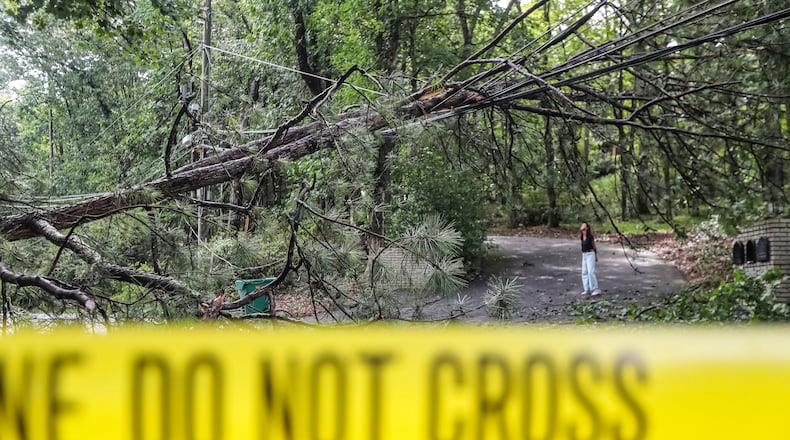Tammy Stafford and her husband were driving home to northwest Georgia from a DeKalb County hospital when the sky turned black and the highway began to flood.
A frantic text message from her daughter urged her to stay exactly where she was.
“The storm is bad. Trees are breaking down everywhere,” Stafford recounted the text stating.
It’s about an 85-mile drive from Emory University Hospital to Stafford’s 20-acre property just south of Chatsworth. Storms began to hit North Georgia as early as about 4 p.m. Thursday, leaving a path of destruction.
On Ga. 411 North around Fairmount, Stafford said she had to pull over. She was one of several drivers who waited for the storm to pass after driving about 30 mph to keep from hydroplaning.
“It was very dark and ominous,” she told The Atlanta Journal-Constitution. “The winds were so bad it was blowing our car.”
Severe thunderstorm warnings went out Thursday afternoon and stretched into the overnight hours as the storms moved southeast into Middle Georgia and eventually South Carolina. Wind gusts reached up to 70 mph across metro Atlanta, according to the National Weather Service, causing trees and powerlines to overturn.
Countless residents woke up Friday to no power. Others were trapped in their homes due to fallen trees blocking roads. That was just some of the damage that ravaged the state as severe storms rolled through.
Credit: Tammy Stafford
Credit: Tammy Stafford
Stafford, 59, has lived on the same property her entire life. It’s been in the family for more than 100 years, she said, and Thursday’s storms were the worst she has ever experienced.
When she got home around 4:30 p.m., she saw several large trees had fallen, taking powerlines down with them. She said her home is also covered in leaves and other debris, but no structures were damaged.
Georgia Power employees knocked on her front door Friday morning, notifying her that her power should return by 11 p.m. — more than 30 hours after the electricity went out.
“As we sit here and have sweat on our brows, there are so many things to be thankful for,” she said.
In Sandy Springs, several residents also remained without power Friday morning. A large tree fell on powerlines along Spalding Road near Hewlett Drive, cutting electricity to people in the area and blocking others in their homes.
“The whole street ... was pitch black, no power. Luckily, we had a generator, so our house had backup power,” resident Jordan Dubrof said.
Power outages in Forsyth County resulted in the loss of operations at the county’s water plant until Friday afternoon. Residents were urged to use water for emergency purposes only, and asked to continue conserving water until noon Saturday .
“I am so grateful to our amazing first responders, line workers and community leaders cleaning up from the severe storms that hit our homes last night,” Rep. Rich McCormick told the AJC. “I am following the situation closely, coordinating with local officials, and talking with Forsyth Sheriff Ron Freeman to ensure my team is at his disposal for cleanup and cooperation.”
Some buildings also suffered severe damage caused by strong winds. In Gordon County, a gym’s exterior brick wall collapsed. No injuries were reported at the Firehouse Gym, located just off I-75 in Calhoun, but the facility will be closed until further notice.
“We’ll come back stronger as a gym family,” manager Robert Melville said.
Credit: Calhoun Police Department
Credit: Calhoun Police Department
In Cherokee County, winds toppled the canopy to a vacant BP gas station, Channel 2 Action News reported. As many as 26,000 county residents lost power Thursday and 13,000 were still in the dark by Friday morning. Amicalola Power told customers it will take multiple days before all the power is restored after finding more than 30 broken power poles.
Several metro officials warned of downed trees blocking roads and fallen powerlines that posed one more hurdle for cleanup efforts.
“If you don’t have to get out and drive, please don’t,” officials in Cherokee County said as the storms began to hit.
Georgia Power said Friday that its crews worked through the night to restore service to more than 200,000 customers, but there were nearly 50,000 customers still without power by the morning. Crews were “still working as safely and quickly as possible to continue restoration,” the company said on Twitter. Georgia EMCs reported as many as 180,000 outages Thursday evening. By early Friday afternoon, about 30,000 customers were still without power, nearly half of whom were in metro Atlanta.
As residents recover and officials quickly work to clear debris and restore power, Channel 2 meteorologist Ashley Kramlich projected that a second round of storms entering the state Friday and continuing into Saturday has the potential to further ravage parts of North and Middle Georgia.
The severe weather and punishing heat is being driven by high-pressure atmospheric conditions in the southwestern part of the United States that have created a dome effect, trapping vast areas of sweltering heat that sometimes prevent rain and clouds that could bring relief to those areas.
Georgia, however, is far enough away from the heat dome that it sits in what meteorologists call “the ring of fire.”
“The ring, meaning the clockwise wind flow around the high pressure. Fire, meaning the thunderstorms that form on the outskirts of this high pressure,” Kramlich said.
“So not only are we getting the heat from this area of high pressure, but we’re also getting the storms because we’re just so far away from the high pressure that we are in that threat area where we get that potential for some strong to severe storms,” she said.




